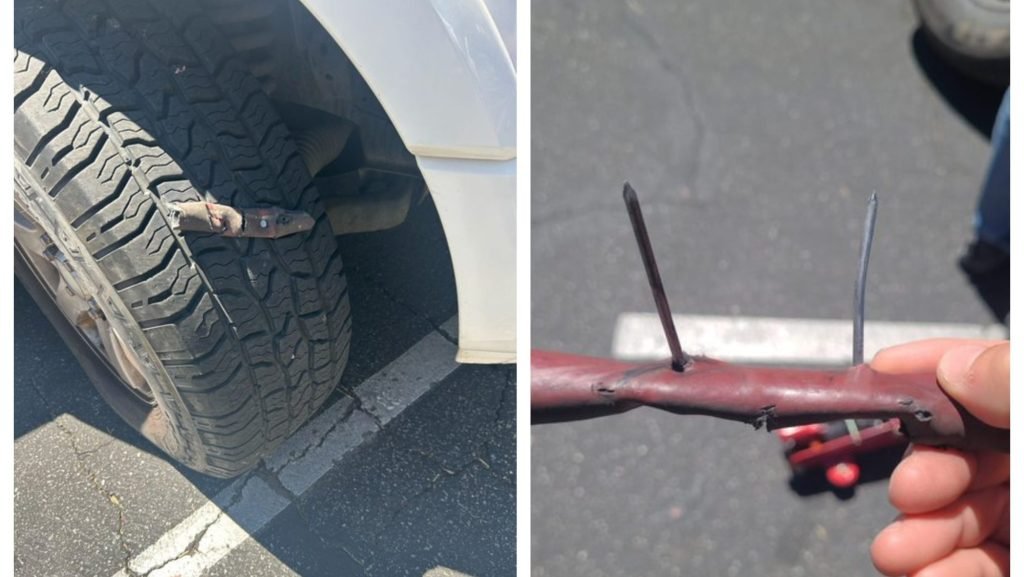Homemade Spike Strips Uncover Fractures in Immigration Enforcement Tactics
A dramatic scene unfolded in Van Nuys, California, as four individuals were arrested on July 8, 2025, for allegedly using improvised spike strips to disrupt a federal immigration enforcement operation. The devices, made of metal and rubber with embedded nails, were clearly designed to incapacitate vehicles—a dangerous, albeit desperate act against the unyielding machinery of U.S. Border Patrol.
U.S. Border Patrol Chief Patrol Agent Gregory Bovino reported startling details about the incident, characterizing it as an attempt to “impede & obstruct our efforts.” The public response has been mixed, reflecting deepening societal rifts over immigration enforcement practices.
Contextualizing Civil Disobedience
The deployment of homemade spike strips, while alarming, is merely a symptom of a larger societal issue concerning the regulation of immigration and the treatment of undocumented migrants. According to Dr. Clara Martinez, a professor of Sociology at UCLA specializing in immigration studies, “Acts of civil disobedience reflect escalating tensions over immigration enforcement. The increasing militarization of border control has catalyzed radical responses” in areas like Van Nuys, which has seen a notable rise in immigrant populations over the past decade.
A recent study by the California Institute for Immigration Policy indicates that immigrant communities have become more organized in their resistance to local and federal enforcement actions. This polarization often breeds confrontations, changing the landscape of immigration discourse.
Understanding the Spike Strip Incident
The incident in Van Nuys raises significant questions about safety, legality, and community relations. The four arrested individuals, whose identities have not been disclosed, face felony charges, highlighting the potential repercussions of such confrontational actions. Beyond the legal implications, however, is the broader narrative of fear and hope within immigrant communities, which are often at odds with federal enforcement priorities.
Details of the spike strips themselves point to a larger narrative about the lengths individuals may go to protect their communities. Observers note:
- The spike strips were fashioned crudely, suggesting impulsiveness rather than premeditated violence.
- Their deployment was likely intended more as an act of protest rather than outright hostility.
- The incident reflects an acute tension between local law enforcement and federal agencies, particularly in urban areas with high immigrant populations.
Local resident Maria Lopez, who has lived in Van Nuys for over 15 years, expressed her ambivalence. “While I don’t condone dangerous actions, I understand the desperation behind it,” she stated. “People are tired of feeling like they’re being hunted.”
The Militarization of Immigration Enforcement
The spike strip incident serves as a poignant reminder of the militarization of immigration enforcement. With more federal personnel on the streets and advanced surveillance technologies becoming common, communities feel increasingly threatened. Bovino’s comments highlight this divide, as he noted that the Border Patrol’s mission is to protect “the safety and welfare of everyone involved.” Yet for many, such assurances ring hollow.
Research from the American Civil Liberties Union shows that increased military-style interventions lead to heightened tensions and weakened public trust in law enforcement. Dr. Samuel Green, a political scientist at Stanford University, commented, “The use of such enforcement tactics often breeds fear, driving community members into silence rather than proactive engagement.”
Voices from the Ground
As the Van Nuys incident unfolds, other community voices advocate for change. “We need more dialogues and fewer confrontations,” argues Elena Rodriguez, the director of a local nonprofit aiding undocumented immigrants. “Building bridges instead of barriers is essential. Both federal and local governments must find ways to engage these communities constructively.”
She suggests that improved community safety education and dialogue between agencies and residents could alleviate suspicions and encourage collaboration. As tensions mount, it may become increasingly important for federal agencies to acknowledge community sentiments rather than merely enforce statutes.
Implications of Violent Resistance
The implications of using violence, even in such an improvised manner, ripple across communities and affect public sentiment on immigration enforcement. The strategy of deploying spike strips suggests a profound disillusionment with conventional means of participation. The immigrants and allies engaged in acts of resistance appear to operate from a place of desperation and urgency, believing their actions may curb further governmental intrusions.
However, as pointed out by Dr. Martinez, such methods can marginalize their cause. “When you cross that line into physical confrontation, you risk alienating potential allies who may be sympathetic to the plight of immigrants but cannot condone violence,” she explained.
Indeed, the stakes are high: the rhetorical framing of immigration struggles continues to evolve in America, where the balance between safety and rights hangs precariously.
The spike strip incident in Van Nuys encapsulates a multifaceted struggle—a confrontation that goes beyond mere legality and taps into the heart of America’s identity concerning immigration and ethnic diversity. As communities grapple with the implications of such actions, there remains a pressing need for comprehensive discussions, nuanced understandings, and, ultimately, solutions that recognize the humanity behind every statistic. In the charged atmosphere of immigration enforcement, the hope is that reason can prevail over desperation, leading to productive dialogue rather than escalating tensions. The future may well depend on it.









